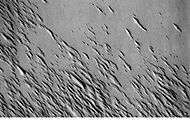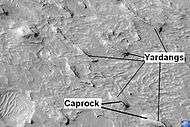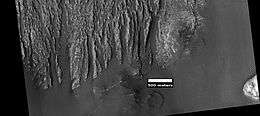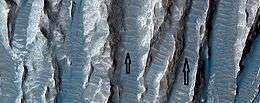Yardangs on Mars
Yardangs are common in some regions on Mars, especially in what's called the "Medusae Fossae Formation." This formation is found in the Amazonis quadrangle and near the equator.[1] They are formed by the action of wind on sand sized particles; hence they often point in the direction that the winds were blowing when they were formed.[2] Because they exhibit very few impact craters they are believed to be relatively young.[3] The easily eroded nature of the Medusae Fossae Formation suggests that it is composed of weakly cemented particles, and was most likely formed by the deposition of wind-blown dust or volcanic ash. Yardangs are parts of rock that have been sand blasted into long, skinny ridges by bouncing sand particles blowing in the wind.[4][5] Layers are seen in parts of the formation. A resistant caprock on the top of yardangs has been observed in Viking,[6] Mars Global Surveyor,[7] and HiRISE photos.[8] Images from spacecraft show that they have different degrees of hardness probably because of significant variations in the physical properties, composition, particle size, and/or cementation.
 Medusae Fossae Formation as seen with Mars Odyssey's THEMIS. Notice elongated formations called yardangs.
Medusae Fossae Formation as seen with Mars Odyssey's THEMIS. Notice elongated formations called yardangs. Yardangs in Medusae Fossae Formation with caprock labeled, as seen by HiRISE. Location is Aeolis quadrangle.
Yardangs in Medusae Fossae Formation with caprock labeled, as seen by HiRISE. Location is Aeolis quadrangle. Yardangs of various sizes, as seen by HiRISE under HiWish program.
Yardangs of various sizes, as seen by HiRISE under HiWish program. Yardangs of various sizes, as seen by HiRISE under HiWish program.
Yardangs of various sizes, as seen by HiRISE under HiWish program. Yardangs formed in light-toned material and surrounded by dark, volcanic basalt sand, as seen by HiRISE under HiWish program.
Yardangs formed in light-toned material and surrounded by dark, volcanic basalt sand, as seen by HiRISE under HiWish program. Close-up image of yardangs, as seen by HiRISE under HiWish program. Arrows point to transverse aeolian ridges, TAR's, a type of dune. Note this is an enlargement of the previous image from HiRISE.
Close-up image of yardangs, as seen by HiRISE under HiWish program. Arrows point to transverse aeolian ridges, TAR's, a type of dune. Note this is an enlargement of the previous image from HiRISE. Yardangs near a crater, as seen by HiRISE under HiWish program Location is in the Amazonis quadrangle.
Yardangs near a crater, as seen by HiRISE under HiWish program Location is in the Amazonis quadrangle. Yardangs, as seen by HiRISE under HiWish program Location is near Gordii Dorsum in the Amazonis quadrangle. These yardangs are in the upper member of the Medusae Fossae Formation.
Yardangs, as seen by HiRISE under HiWish program Location is near Gordii Dorsum in the Amazonis quadrangle. These yardangs are in the upper member of the Medusae Fossae Formation. Yardangs, as seen by HiRISE under HiWish program Location is near Gordii Dorsum in the Amazonis quadrangle. Note: this is an enlargement of previous image.
Yardangs, as seen by HiRISE under HiWish program Location is near Gordii Dorsum in the Amazonis quadrangle. Note: this is an enlargement of previous image. Yardangs, as seen by HiRISE under HiWish program Location is near Gordii Dorsum in the Amazonis quadrangle. Note: this is an enlargement of previous image.
Yardangs, as seen by HiRISE under HiWish program Location is near Gordii Dorsum in the Amazonis quadrangle. Note: this is an enlargement of previous image. Yardangs showing layers, as seen by HiRISE under HiWish program Location is Aeolis quadrangle.
Yardangs showing layers, as seen by HiRISE under HiWish program Location is Aeolis quadrangle. Wide view of yardangs, as seen by HiRISE under HiWish program Location is Memnonia quadrangle.
Wide view of yardangs, as seen by HiRISE under HiWish program Location is Memnonia quadrangle. Close view of yardangs in previous image, as seen by HiRISE under HiWish program Location is Memnonia quadrangle.
Close view of yardangs in previous image, as seen by HiRISE under HiWish program Location is Memnonia quadrangle. Close view of yardangs from a previous image, as seen by HiRISE under HiWish program Location is Memnonia quadrangle.
Close view of yardangs from a previous image, as seen by HiRISE under HiWish program Location is Memnonia quadrangle.
See also
References
- ↑ SAO/NASA ADS Astronomy Abstract Service: Yardangs on Mars
- ↑ http://www.esa.int/Our_Activities/Space_Science/Mars_Express/Yardangs_on_Mars
- ↑ http://themis.asu.edu/zoom-20020416a
- ↑ http://www.uahirise.org/ESP_039563_1730
- ↑ http://www.uahirise.org/ESP_039563_1730
- ↑ Scott, David H.; Tanaka, Kenneth L. (1982). "Ignimbrites of Amazonis Planitia Region of Mars". Journal of Geophysical Research. 87: 1179–1190. Bibcode:1982JGR....87.1179S. doi:10.1029/JB087iB02p01179.
- ↑ Malin, MC; Carr, MH; Danielson, GE; Davies, ME; Hartmann, WK; Ingersoll, AP; James, PB; Masursky, H; et al. (March 1998). "Early views of the martian surface from the Mars Orbiter Camera of Mars Global Surveyor". Science. 279 (5357): 1681–5. Bibcode:1998Sci...279.1681M. doi:10.1126/science.279.5357.1681. PMID 9497280.
- ↑ Mandt, Kathleen E.; De Silva, Shanaka L.; Zimbelman, James R.; Crown, David A. (2008). "The origin of the Medusae Fossae Formation, Mars: Insights from a synoptic approach". Journal of Geophysical Research. 113: 12011. Bibcode:2008JGRE..11312011M. doi:10.1029/2008JE003076. hdl:10088/7052.